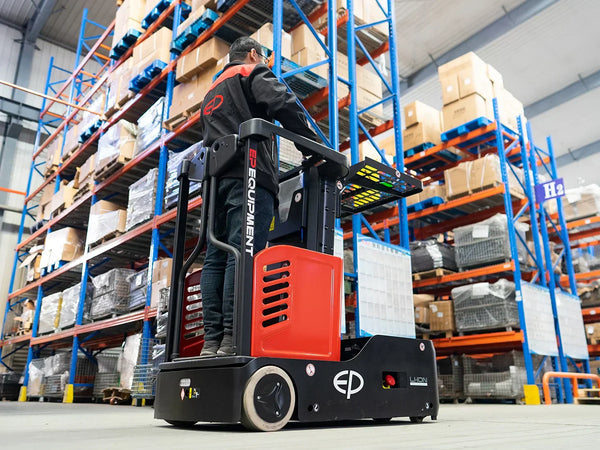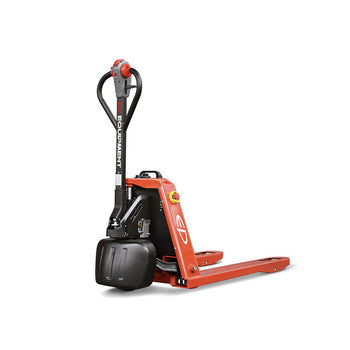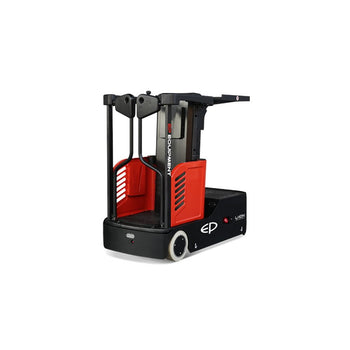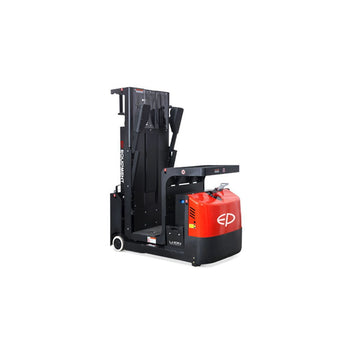Efficient order picking is the backbone of modern fulfilment. The time employees spend travelling through aisles, locating items, checking paperwork and extracting products can consume more than half of the fulfilment cycle. Research from the Georgia Tech Supply Chain & Logistics Institute shows that travel accounts for about 55 % of a picker’s time, followed by paperwork and other activities (20 %), searching (15 %) and extracting (10 %). In the face of rising e‑commerce orders and tight service‑level agreements, companies that fail to optimise the picking phase risk higher labour costs, shipping delays and lost customers.
This article explores best practices and technology upgrades that boost picking speed and accuracy. It also highlights how iLift’s electric order pickers and pallet trucks – powered by reliable EP lithium‑ion technology – can be an operational partner for businesses seeking to modernise their warehouses.
Understanding Order Picker Machines
Order picker forklifts (also called stock pickers or cherry pickers) are Class II electric narrow‑aisle trucks designed to lift an operator to shelving so they can retrieve individual items. A compact chassis with a single drive wheel allows these machines to turn sharply and navigate narrow aisles. Operators stand on a guarded platform behind the battery and use a steering wheel and joystick to drive. Controls on the platform raise or lower the mast so the picker can reach the desired shelf.
Unlike counterbalance forklifts that move entire pallets, order pickers are built for piece picking. High‑level models can lift operators to 9 – 14 metres, enabling retrieval of stock from top racking without ladders. Because they are battery powered, they produce no exhaust and are quiet, making them ideal for indoor warehouses.
iLift’s order picker range
To meet the growing need for safe, efficient picking, iLift offers highly innovative vertical order pickers. The JX0 and JX1 models combine manoeuvrability and operator comfort:
-
JX0 electric vertical order picker – This model uses a conventional steering wheel for precise control in tight spaces. It features a duplex mast that reaches 3 metres and carries up to 90 kg. A built‑in 24 V lithium‑ion battery delivers a long runtime.
-
JX1 electric vertical order picker – Designed for heavier-duty applications, the JX1 has a stable mast and large operator platform. Operators can handle bulkier goods safely while enjoying clear visibility.
Both machines provide vertical movement at the push of a button, saving significant time compared with climbing ladders or using manual lifts. iLift emphasises safety by fitting guardrails, adjustable platforms and strategically positioned controls. The result is reduced operator strain and a lower risk of injury.
Best practices for improving picking efficiency
Design your warehouse for minimal travel
Since travel is the biggest component of pick time, thoughtful layout and flow can yield major gains. Studies recommend designing warehouses in U‑, L‑ or I‑shaped flows depending on volume and space. U‑shaped flow places receiving and dispatch on the same side of the building, ideal for smaller sites; I‑shaped flow puts receiving at one end and dispatch at the other for high volumes; L‑shaped flow positions dispatch perpendicularly for easier cross‑docking. Along with flow, zone your facility into fast‑moving, medium‑moving and slow‑moving areas so that high‑velocity items are close to packing stations.
Other layout tactics include:
-
Place popular SKUs in the golden zone – Position frequently picked products at waist‑to‑shoulder height to minimise bending and stretching. Use ABC analysis to categorise inventory: A‑items (fast movers) near packing, B‑items in the middle and C‑items farther away.
-
Reduce aisle width only if equipment allows – Narrow aisles shorten travel distance but require appropriate machines. iLift’s compact order pickers navigate narrow passages easily and improve cubic capacity by enabling vertical storage.
-
Group items sold together – Place products commonly ordered together in adjacent slots to reduce backtracking.

Adopt efficient picking methods
Choosing the right picking method depends on order volumes and SKU diversity. Proven strategies include:
-
Discrete (picker‑to‑part) – A picker walks through the entire warehouse to assemble one order. Suitable for small operations with low order volume, it offers high accuracy but involves more walking.
-
Batch picking – Pickers collect items for multiple orders simultaneously, reducing travel when orders share SKUs. Best for processing many low‑line orders.
-
Zone picking (pick‑and‑pass) – The warehouse is divided into zones; each picker retrieves SKUs from their area before passing the order downstream. Ideal for large facilities with diverse products.
-
Wave picking – Orders are released in scheduled waves, combining elements of batch and zone methods to balance workload.
Select the method that aligns with your order profiles and adjust as volumes fluctuate. For example, low‑volume SKUs may be picked discretely while popular items are batched during peak hours.
Prioritise training and standardisation
Errors erode customer trust and cost money, so training is critical. Document standard operating procedures for receiving, stocking, picking, packing and shipping. Cross‑train staff across functions so they can flex during seasonal spikes. Gamification—tracking accuracy and speed on leaderboards—can boost morale and performance.
Establish metrics to monitor performance. Order picking accuracy averages around 96–97 %; best‑in‑class operations reach 99.8 %. Track lines picked per labour hour, cost per error and on‑time in‑full delivery rates. Data‑driven visibility helps pinpoint bottlenecks and measure improvement.
Technology upgrades that transform picking
Warehouse management systems (WMS)
A WMS stores and tracks SKU locations, creates pick lists and directs pickers along the most efficient route. Even basic systems ensure that you are not picking single orders one at a time. They automatically generate instructions, consider warehouse layout and available labour and help maximise efficiency and accuracy. When integrated with mobile devices, a WMS can also track metrics and trigger alerts for discrepancies.
Mobile scanning and barcoding
Barcoding is an inexpensive but powerful upgrade. Printing SKU labels and using scanners reduces manual entry errors by 40–60 %. Handheld barcode scanners priced between £240 and £650 quickly verify selections, provide audio/visual error alerts and allow batch confirmation of multiple items. The return on investment can be realised within six months because fewer mistakes mean fewer returns and happier customers.
Pick‑to‑light and voice technologies
For higher volumes, light‑directed systems illuminate picking positions and indicate quantities, enabling untrained workers to pick accurately. These systems cost about £4,000–£12,000 per installation and deliver labour efficiency gains of 30–50 %, with payback periods of 12–18 months. Voice picking uses headsets to guide operators to the correct location, leaving hands free and improving ergonomics. Both technologies integrate with WMS and support multilingual workforces.
Automated and semi‑automated equipment
Semi‑automated tools reduce physical strain by up to 80 %. For example, vacuum lifters and multifunctional suction devices mount on forklifts or pallet trucks, allowing operators to move heavy boxes without manual lifting. High‑frequency lifters use joystick controls for precision handling of odd‑shaped loads. These investments create safer work environments and speed up loading/unloading.
Automated storage and retrieval systems (AS/RS) — including vertical lift modules and autonomous mobile robots — maximise vertical storage and automate retrieval. While high‑end, they enable 24/7 operations and support high‑volume warehouses. For most businesses, a hybrid approach combining human pickers with semi‑automated equipment offers the best balance of flexibility and throughput.
Quality control and real‑time validation
Digital verification methods catch mistakes before orders leave the warehouse. Scan‑verify stations compare barcode scans with order requirements, weight‑based systems check actual weight against expected weight, and photo capture records package contents. A robust WMS can flag anomalies so supervisors can intervene immediately. These controls maintain accuracy without slowing throughput.
iLift as your operational partner
Beyond supplying equipment, iLift positions itself as a partner to improve your warehouse efficiency. Here’s why:
-
Lithium‑ion powered performance – All iLift equipment, including order pickers and pallet trucks, uses lithium‑ion batteries, delivering zero emissions, low noise and sensitive driving characteristics. Long run times and fast charging maximise uptime.
-
Diverse pallet trucks – iLift’s EPL series includes models like the EPL1531 and EPL154/185 that handle 1 500–1 800 kg loads. The RPL series supports capacities up to 3 000 kg. Electric pallet trucks allow operators to move heavier loads easily and quietly, reducing fatigue and improving safety; manual trucks typically max out at 600 kg.
-
EP technology – iLift stocks EP equipment because the manufacturer is a leader in lithium‑ion forklifts and pallet trucks. EP products ensure efficient, safe operations, and iLift selects them to provide the best quality to its clients.
-
Compliance and support – All pallet trucks are LOLER certified and inspected by accredited engineers. iLift provides global shipping and handles logistics, and it offers maintenance and repairs to keep fleets running.
-
Expert guidance – iLift’s specialist team helps businesses choose the right order picker or pallet truck for their needs. Whether you’re unsure about required lift height or capacity, the team provides personalised advice. Every product is accompanied by training and service support.
Partnering with iLift means more than purchasing machinery; it’s about integrating modern equipment, training and aftercare into your operational workflow to achieve continuous improvement.

Achieving future‑ready picking efficiency
Improving order picking speed and accuracy is a continuous process. Start by redesigning your warehouse layout to minimise travel time and grouping fast‑moving SKUs near dispatch areas. Choose picking methods (discrete, batch, zone or wave) that match your order profiles. Standardise procedures and train staff; cross‑training will give you flexibility during seasonal peaks. Implement a WMS, invest in mobile scanning, and consider pick‑to‑light or voice systems for higher volumes. Evaluate semi‑automated lifting tools to reduce physical strain and speed up handling.
iLift’s electric order pickers and pallet trucks offer a platform to implement these best practices. The JX0 and JX1 order pickers provide safe, ergonomic vertical access to high racking, while the EPL and RPL pallet trucks handle heavy loads with ease. Every machine is backed by lithium‑ion technology, LOLER certification and expert support. By collaborating with iLift, businesses gain a reliable partner committed to enhancing warehouse performance.
Ready to accelerate your picking efficiency? Explore iLift’s electric order picker range and discover versatile electric pallet trucks to see how the right equipment can transform your operations. For tailored advice, contact iLift at 01600 800 800 or email enquiry@ilift.co.uk.





